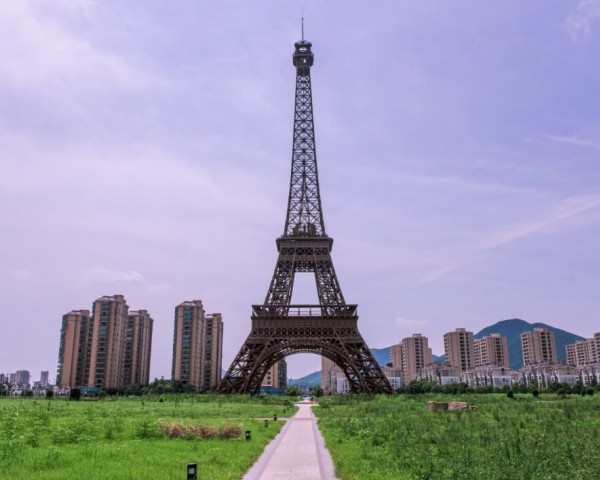In various parts of Asia, there are reproductions of famous European cities and landmarks. For example, in Vietnam, Malaysia, and China, there are replicas of European cities, iconic structures like the Eiffel Tower, and gardens reminiscent of those found in France. Similarly, there are replicas of Austrian villages in China, an English-style town near Shanghai, and a Dutch-themed park in Japan. Interestingly, there are no such replicas of Asian architecture in Europe besides Chinese-inspired decorations in Chinatowns.
In the 1990s, copies of Western World started appearing in China. This resulted from economic and demographic growth, as megacities needed to expand to accommodate a growing and wealthier population. Architects sought to distinguish these new developments from the communist and Soviet “style” by taking inspiration from Europe, which was seen as a model of success by the Chinese, who aspired to adopt its way of life. This information is from Bianca Bosker, an American journalist and author of “Original Copies: Architectural Imitation in Contemporary China.”
Duplicating Architecture
The tradition of “duplitecture” has roots that date back several millennia. The term is a combination of “duplication” and “architecture.” In the third century BCE, Qin Shi Huang, who unified the Chinese Empire, used to build replicas of the palaces from each conquered kingdom in his capital. While plagiarism is often considered kitsch, false, and illegal in the West, it is viewed as a sign of talent in China and a way of promoting the original. Bianca Bosker draws parallels with counterfeits in technology and fashion.
One of the most notable city replicas is Tianducheng, a copy of Paris located 30 km from Hangzhou. It is part of the “One City, Nine Towns” project initiated in 2001 by the Shanghai municipality. Despite being only partially completed, the project aimed to create nine large thematic districts, each representing a European country. Over fifteen years since its emergence, Tianducheng has only 30,000 inhabitants, three times fewer than expected. Despite this, the city has unintentionally become a popular tourist attraction for Chinese and foreigners and a spot for newlyweds to capture memories of their union.
A World Tour without Leaving One’s Country
Some replicas are designed to be inhabited, while others are tourist attractions with set opening and closing hours, similar to Disneyland. Examples of this are the Huis Ten Bosch parks in Japan and Ba Na Hills in Vietnam. According to anthropologist Jean-Didier Urbain, these theme parks are created by countries to align with international tourism, which they have recently embraced. For domestic visitors, these places provide the experience of traveling the world, which may have been inaccessible due to historical reasons such as war, isolationism, political situations, or financial constraints.
As researchers Bauer Bernhard and Canestrini Duccio noted, these replicas of European cities are found in destinations that must reinvent themselves to remain competitive in the global tourism market. These places lack world-class tangible and intangible assets and rely on importing and recreating successful attractions from other places. For example, the Eiffel Tower’s iconic nature attracts visitors in Paris, Las Vegas, and Shenzhen due to its recognizability and popularity.
Safeguard Heritage
Tourist destinations that are replicas of famous cities allow the Chinese to experience a modern version of the Grand Tour without leaving their country, similar to the journey undertaken by young English nobles in the 17th and 18th centuries. Travel agencies even offer “world tours” in a few days with stops in each city. “At a time when travel is criticized for its impact on the environment, these miniature cities are part of the local tourism trend. We no longer go to the world; it’s the world that comes to us,” says Jean-Didier Urbain.
In addition to their tourist appeal, these replicas serve a memorial purpose. “Copying is a way of safeguarding heritage,” adds the anthropologist, citing the example of the Lascaux cave in France. Degraded by carbon dioxide from visitors’ breathing, the cave was closed in 1963, only fifteen years after its opening. It now includes two accurate replicas (Lascaux II and IV) and a traveling version (Lascaux III). With increasing threats to world heritage, such as rising water levels and natural disasters, these replicas ensure that the heritage continues to exist even if the original sites are lost. For example, if Venice were to disappear, it would still exist through its copies spread worldwide.
A “French Village” in Vietnam
In the inland area of Da Nang, central Vietnam, one of the most popular tourist destinations is a miniature version of France. For about forty euros a day, a luxury for most locals, visitors can take the cable car to the summits of Ba Na Hills. This cable car is one of the longest in the world, spanning 5,771 meters. During the colonial era, the French used this area as a vacation spot to escape the intense heat. Though no remnants of that era remain, the mountains now house a “French Village” within an amusement park managed by Sunworld, a Vietnamese tourism giant.
Initially, the Disneyland-like aspect of the place may be off-putting, but curiosity eventually triumphs. At an altitude of 1500 meters, trains and ski lifts transport visitors between a replica Parisian square and an imitation of Provence, all departing from stations with names like “Bordeaux,” “Marseille,” and “Louvre Station.” On the central square, you can take a break in the shade of a statue of Victor Hugo, near the Moulin Rouge and cafes that promise “hot croissants at any time”. In various spots, newlyweds pose for photos in front of the cathedral or the paths of the Jardin d’Amour.













